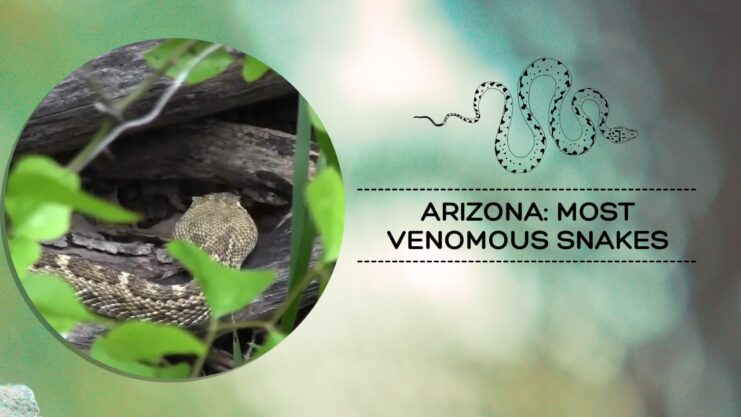Arizona, a state known for its diverse wildlife and stunning landscapes, is also home to a variety of snake species. Among these, a significant number are venomous, posing potential risks to humans and pets.
This article will delve into the fascinating world of venomous snakes in Arizona, focusing on their characteristics, habitats, and behaviors. We will also provide valuable insights into how to identify these snakes and what to do if you encounter one.
In the Stone Canyon area of Oro Valley, Arizona, four venomous snake species have been identified. These include the Western Diamondback Rattlesnake, the Black-tailed Rattlesnake, the Tiger Rattlesnake, and the Sonoran Coral Snake. Let’s learn more about them!
1. Western Diamondback Rattlesnake (Crotalus atrox)
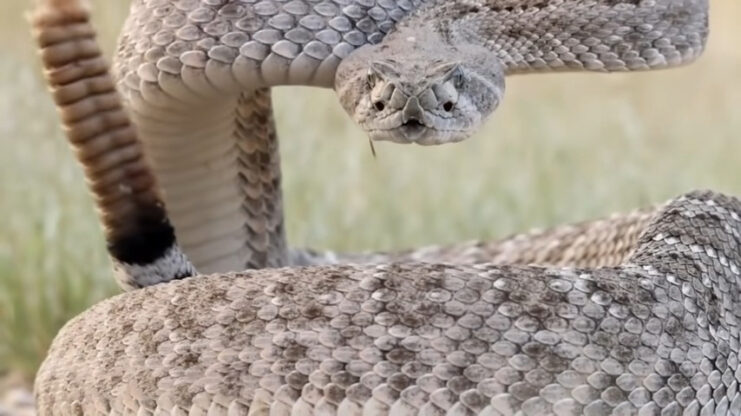
The Western Diamondback Rattlesnake is Arizona’s largest rattlesnake, capable of growing up to 1,676mm in size.
They are known for their large venom yields and potent hemorrhagic toxins that can cause tissue damage. These snakes are most commonly seen during their mating times in the spring and during the monsoon season.
2. Black-tailed Rattlesnake (Crotalus molossus)
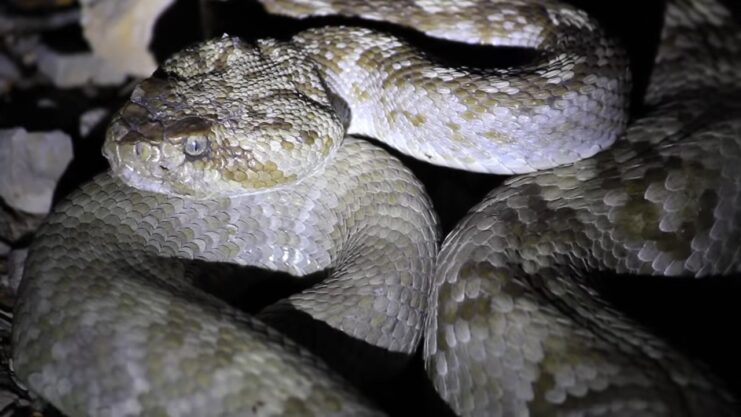
The Black-tailed Rattlesnake is a flashy snake that is almost always found within rocky, mountainous landscapes. Like the Western Diamondbacks, they produce large venom yields and potent hemorrhagic toxins that can result in tissue damage.
Their activity peaks during the monsoon season, which coincides with their mating season from July to September.
3. Tiger Rattlesnake (Crotalus tigris)
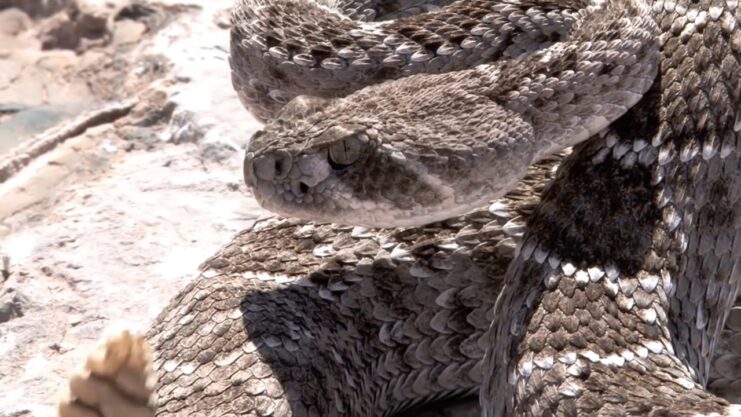
The Tiger Rattlesnake is unique among other rattlesnakes due to the small size of its head in proportion to its body. The striking tiger-striped markings are a dead giveaway for this species.
The venom of the Tiger Rattlesnake is a neurotoxin, making it exceptionally toxic. These snakes are most active and likely to be seen during the summer monsoons.
4. Sonoran Coral Snake (Micruroides euryxanthus)
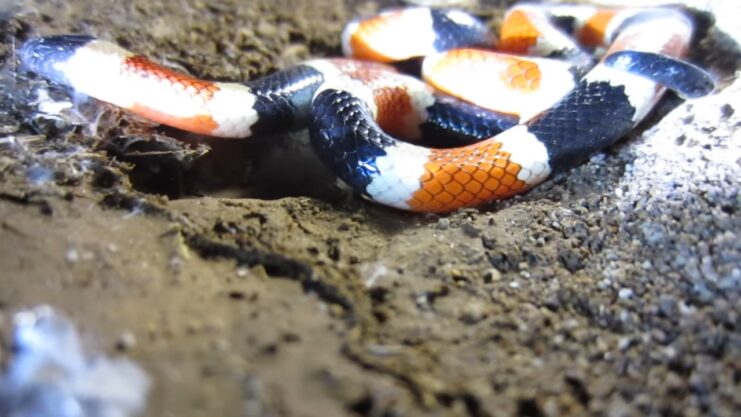
The Sonoran Coral Snake is the only venomous, non-rattlesnake species of snake in Arizona. They are small and generally docile, but should not be handled due to the potential risk of envenomation with neurotoxins.
| Venomous Snake Species | Size | Venom Type | Peak Activity |
|---|---|---|---|
| Western Diamondback Rattlesnake | Up to 1,676mm | Hemorrhagic toxins | Spring and Monsoon season |
| Black-tailed Rattlesnake | Medium to Large | Hemorrhagic toxins | Monsoon season |
| Tiger Rattlesnake | Medium | Neurotoxin | Summer monsoons |
| Sonoran Coral Snake | Small | Neurotoxin | Varies |
The table above provides a quick reference to the venomous snakes found in Arizona. It’s important to note that while these snakes can be dangerous, they generally avoid human interaction and only strike when threatened or provoked.
Non-Venomous Snakes in Arizona
In addition to the venomous species, Arizona is home to a variety of non-venomous snakes. Find out more about them by checking the table below:
| Non-Venomous Snake Species | Habitat |
|---|---|
| Glossy Snake | Desert, grasslands |
| Variable Sandsnake | Sandy soils |
| Ring Necked Snake | Forests, grasslands |
| Night Snake | Deserts, grasslands |
| Common Kingsnake | Various habitats |
| Western Threadsnake | Deserts, grasslands |
| Sonoran Whipsnake | Deserts, grasslands |
| Saddled Leaf-nosed Snake | Deserts |
| Spotted Leaf-nosed Snake | Deserts |
| Gopher snake | Various habitats |
| Long-nosed snake | Deserts, grasslands |
| Western Patch-nosed Snake | Deserts, grasslands |
| Western Ground Snake | Deserts, grasslands |
| Smith’s Black-headed Snake | Deserts |
| Black-necked Garter Snake | Near water bodies |
| Western Lyresnake | Rocky areas |
These snakes are harmless to humans and play a crucial role in controlling pest populations. Remember, the best way to stay safe is to respect these creatures from a distance and never attempt to handle them. If you do encounter a snake, remain calm and slowly back away.
If you or someone else is bitten, seek immediate medical attention.
Safety Measures
While the presence of venomous snakes can be intimidating, it’s important to remember that they are not naturally aggressive toward humans. Most snake bites occur when a snake is provoked or accidentally stepped on. Therefore, being aware of your surroundings, especially in areas known for snake activity, is crucial.
If you encounter a snake, it’s best to give it space and allow it to move away. Never attempt to handle or kill a snake. If you or someone else is bitten, seek medical attention immediately. While not all snake bites are life-threatening, it’s essential to get professional help as quickly as possible.
In addition to being aware of your surroundings, it’s also important to wear appropriate clothing when in areas known for snake activity. Long pants and boots can provide an extra layer of protection against snake bites.
If you’re hiking, stick to well-used trails and avoid tall grass, piles of leaves, and rocky or cluttered areas where snakes may be hiding. At night, use a flashlight to illuminate your path.
Educate your children about the importance of not touching any snakes they encounter. Pets should also be kept on a leash to prevent them from disturbing a snake.
Lastly, consider learning basic first aid for snake bites, including what not to do, such as attempting to suck out the venom or applying a tourniquet, as these methods can often do more harm than good.
Conclusion
Arizona’s venomous snakes are an integral part of the state’s rich biodiversity. While they may pose risks, understanding their behaviors and taking appropriate precautions can significantly reduce the chances of negative encounters.
While Arizona’s venomous snakes are fascinating, it’s also interesting to note the variety of venomous snakes found in other states, such as Arkansas, which is home to five distinct species of venomous snakes.
Don’t forget that these creatures play a vital role in maintaining the ecosystem balance, and their presence is a testament to the health of the state’s natural habitats.

